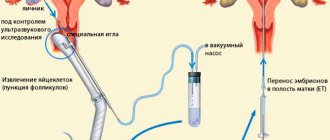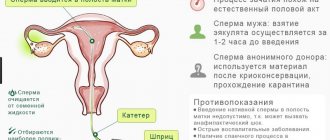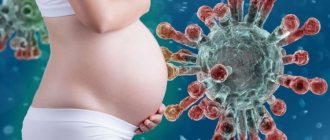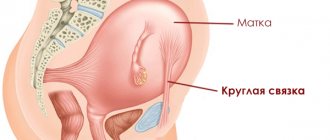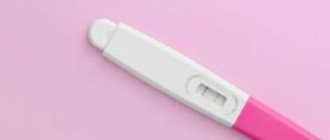In our time, in vitro fertilization is one of the main methods to combat infertility. The process itself is very complex and lengthy, but the result is worth it. One of the main stages of IVF is the transfer of embryos into the uterine cavity and their implantation (attachment of a fertilized egg to the inner muscle layer of the uterus). During IVF, women are usually implanted with 3- or 5-day-old embryos. Let's look at how three-day embryos are implanted.
Blastocyst transfer during IVF: a little theory
During the period of preparation for in vitro fertilization, a woman’s body is subjected to severe stress. The ovaries are stimulated using medications. Not one or two, but many dominant follicles grow in them. Shortly before ovulation, they are extracted using modern medical methods. Then, under special conditions, they are fertilized by male cells.
Just a few years ago, doctors were confident that it was necessary to transfer three-day-old embryos. This opinion was formed because a day later most of the cells simply died. Laboratory technicians and reproductive specialists could not create appropriate conditions for their survival. Now, using new techniques and materials, blastocyst transfer can be performed. This is a set of cells that developed in a test tube for five days.
Adviсe
Here are some simple tips to help you follow all the recommendations after completing the IVF protocol.
- Familiarize yourself with IVF statistics and immediately accept the fact that failure is more likely than success. This will help you calm down, reconcile and more adequately perceive the result, whatever it may be.
- Protect yourself from quarrels, conflicts, showdowns, watching “bloody” films with scenes of violence - all this has an undesirable effect on your mood and well-being.
- If the work involves risks, exposure to harmful substances, toxins, noise, vibration, take sick leave and spend these two weeks in safety.
- Various “smart” appliances (washing machines, dishwashers, multicookers) will greatly facilitate your household work and leave more time for much-needed rest and sleep after the procedure.
- You shouldn’t go to extremes and go somewhere to a warm sea coast in search of peace. Exposure to the sun is contraindicated; besides, acclimatization can cause a lot of trouble and interfere with normal implantation of embryos.
- A woman should not drive a car for two weeks. The very process of driving a vehicle cannot harm the embryo in any way, but stressful situations that sometimes occur on the road every kilometer may well cause harm.
Advantages and disadvantages
Most doctors, geneticists and reproductive specialists say that blastocyst transfer is about 60 percent successful. Whereas three-day-old embryos have only a 30 percent chance of implanting in the reproductive organ. Why is there such a distinction? Everything is very simple.
After transfer, the blastocyst is ready to immediately penetrate the endometrium, that is, implant. Three-day embryos during natural fertilization are still in the fallopian tube. It takes them an average of two more days to reach the uterus. That is why in such situations there is a risk of failure.
The undoubted advantage of blastocyst transfer is the high probability of a successful outcome. However, manipulation also has disadvantages. Some laboratories are not able to create conditions for the survival of embryos in this condition. Therefore, some of them die on the fourth day. Reproductionists note that the same probability of survival would have been in the uterine cavity if three-day-olds had been implanted. A blastocyst is a collection of cells ready to hatch from its shell and implant in the uterus. At this stage of embryo development, there is a greater chance of detecting any abnormalities.
Fertilization assessment
Fertilization assessment is carried out in the morning of the day following the puncture. This day is considered the 1st day of embryonic development.
The opportunity to understand whether cell fertilization has occurred appears 18 hours after fertilization and is characterized by the formation of pronuclei. The embryo of the first day of development is called a zygote.
On this day, the embryologist evaluates the “correctness” of fertilization. A normally fertilized oocyte contains 2 pronuclei. All other options are considered a deviation.
Triploid embryo (3pn)
Abnormally fertilized embryos are excluded from cultivation.
Blastocyst cryotransfer: implantation
Often, when a large number of eggs are collected, fertilized embryos are frozen. Usually this procedure is carried out on the third day. However, under certain conditions, freezing can also be carried out with a blastocyst. The storage conditions for embryos with five days of development are the same as for three-day-old embryos.
When the need arises for their use, the cells undergo reverse transformation and are introduced into the woman’s uterus. Implantation of blastocysts in a cryoprotocol has the same probability as in a regular one. In this situation, only the conditions for preparing a woman change.
Assessment of the quality of embryos 2-3 days of development
Starting from the second day of embryonic development, the cleavage phase begins.
Cleavage is the synchronous rapid division of the embryo into equal large cells. These cells are called blastomeres. The quality of the embryo is assessed by the uniformity of blastomeres. The more uniform blastomeres the embryo contains, the better its quality is considered. Embryos of a given day of development are assessed by the number of blastomeres (indicated by a number) and by additional criteria, such as the uniformity of blastomeres and the presence of fragmentation (assessed by the Latin letters a,b,c,d and their combination).
A good quality embryo looks like this.
How is the procedure performed?
After the eggs are removed from the woman’s body, their replantation occurs exactly 5 days later. Blastocysts are transferred and hCG is injected immediately. After this, the woman should be at rest for some time. Most transfers are performed under light anesthesia. If necessary, the woman’s condition is monitored through ultrasound diagnostics. Can a blastocyst divide after transfer? Theoretically this is possible. After all, after replanting, the cells go through an important stage - hatching. Only after this they are implanted into the uterus. However, such an outcome of events happens very rarely.
After the manipulation, the patient carefully monitors her sensations. Also, the woman must follow the regimen prescribed to her and take medications. Most of them are hormones. What does it feel like to have a successful set of circumstances? Let's look at it below.
Positive pregnancy test
When do the tests run after blastocyst transfer? This question is asked by every woman after in vitro fertilization. You can see a positive pregnancy test result immediately after the procedure. However, this will not mean that you are pregnant. It is worth clarifying this situation a little.
After the blastocyst transplant, the woman is given an injection of human chorionic gonadotropin. This hormone begins to be produced independently during natural pregnancy immediately after fertilization. It prepares the endometrium and uterus for a new state. And this is what most pregnancy tests react to. In other words, the study will show you the presence of this hormone in the body. However, this will only be a reaction to the injection. Gradually, artificial hCG is eliminated, and when implantation occurs, its own substance begins to be produced. This happens approximately 7-10 days after the transfer. That's when you can get a 70 percent chance of getting the correct pregnancy test result.
First days
The embryo transfer procedure itself is not at all painful and simple. It only lasts five minutes. Using a thin catheter, the doctor introduces a certain number of embryos with a small amount of nutrient medium into the woman’s uterine cavity. This is where the competence of doctors ends. What will happen in the uterine cavity after this is as much a mystery for doctors as it is for the patient herself.
For at least two weeks, the question of whether the embryos were able to implant into the endometrium of the uterus remains open.
The success rate for the first IVF attempt is about 35-45%. The likelihood of implantation is influenced by the woman’s age, her state of health, her lifestyle, the quality and viability of the resulting embryos and the state of the endometrium itself, its readiness to “accept” the fertilized egg. Much depends on luck and faith, on “higher powers,” if you like.
After embryo transfer, the woman is recommended to lie in a horizontal position with her legs elevated for the first hour. Most often - on a gynecological chair, on which the embryo transfer was carried out. She is then allowed to get dressed and leave the clinic. The doctor must give his recommendations on behavior after embryo transfer.
In the first days, embryos usually float in the uterine cavity, starting from the third day after transfer it is already possible that the embryo is implanted. The implantation process itself after transfer usually lasts longer than during implantation after natural conception. A woman should try to spend as much time as possible in peace. The best thing to do is lie down, read, watch a kind and positive cartoon. It is better to postpone all household chores or entrust them to one of your relatives. Sleep, good nutrition and rest in these first days after the final stage of the IVF procedure are of great importance.
Among the common sensations after the transfer are a slight nagging pain in the lower abdomen, in the area of the ovaries, a slightly more abundant discharge, sometimes spotting, sometimes even cinnamon or pinkish. A woman may experience dizziness, bouts of nausea, and often have a headache. This is due to the effects of hormonal stimulation of the ovaries.
After a couple of days, you can spend more time on your feet. But you shouldn’t rush headlong into the usual rhythm of life. It is advisable for a woman to exclude any stress and anxiety, eat well, avoid sex, and breathe fresh air. You cannot take hot baths, sunbathe, swim, or visit the sauna or bathhouse.
On the 14th day after the transfer, you can take a blood test to determine the concentration of hCG in the plasma. If pregnancy occurs, the hormone level will be elevated. On the 21st day, you can do the first ultrasound, which can confirm the fact of pregnancy, as well as determine how many of the implanted embryos have taken root. On the 28th day after embryo transfer, a repeat ultrasound is performed, which makes it possible to determine the rate of development of each baby that has taken root, as well as their viability.
It is most difficult to survive until 14 days from the moment of transfer. Women describe this time as a long and painful wait. Experts recommend stopping listening to yourself in search of signs of pregnancy and focusing your energy on organizing the right lifestyle that will contribute to the success of the IVF protocol. Let's look at some aspects of these recommendations.
Bed rest
On the first day - maximum two - bed and semi-bed rest is desirable. In this case, it is necessary to place a small bolster or pillow under the lower back so that the pelvis is slightly higher than the body. Bed rest in the first days does not mean that a woman needs a nurse, since she cannot drink or go to the toilet. She can easily go to the toilet on her own, as well as walk to the kitchen and pour herself some tea. But she still has to spend 95% of her time in bed.
Already on the third day, a woman can and should begin to get up, gradually alternating periods of rest with periods of light and unburdensome activity. A longer stay in a horizontal position is unacceptable - the pelvic organs from prolonged lying will become less filled with blood, which can significantly reduce the likelihood of implantation.
A week after the transplantation, the woman can lead a normal life, observing the usual motor pattern. The ban applies to lifting weights, jumping, training in the gym, cycling, and running. But evening walks in a park or square, away from polluted and noisy highways, will be useful.
Medicines
For many women, the stimulated protocol recommends progesterone support after the transfer. It usually starts on the day of replanting. The specific drug and individual dosage are recommended by the reproductologist who carried out the protocol.
Progesterone is important for implantation to be more successful, as well as for maintaining pregnancy in the very first days after implantation, because an implanted fertilized egg may well be rejected.
A woman should pay special attention to these drugs. Set a reminder on your phone, because it is advisable to take them at the same time every day. Skipping a pill, increasing or decreasing the dose without the knowledge of the doctor is strictly prohibited. Progesterone medications are taken until pregnancy is diagnosed. If it occurs, sometimes you have to take this pill until 12-14 weeks of pregnancy in order to maintain it. If, according to the results of tests and ultrasound, the IVF protocol was unsuccessful, the drug should be stopped. Your period will come 2-3 days after the cancellation.
You should not take any other medications after the transfer. Any tablets, suppositories, syrups must be taken only with the permission of a doctor. Often, to reduce discomfort after the protocol - lower back tension, headache - it is allowed to take antispasmodics - “No-shpu”, “Papaverine”. With an increased level of anxiety, a woman may be allowed to take light herbal sedatives - motherwort (not alcohol tincture!), valerian (in tablets).
Nutrition
Nutrition should be approximately the same as at the stage of preparation for IVF - with a predominance of protein foods, fresh fruits and vegetables, and fresh herbs in the diet. The woman can continue to take the multivitamins that were approved for her by her doctor during the pre-protocol phase, folic acid.
After embryo transfer, special attention should be paid to nutrition, since during the first week it is important to avoid constipation. The delayed effect of hormonal therapy at the stage of superovulation stimulation can appear right now, causing intestinal disorders, diarrhea, constipation, and increased gas formation. Progesterone taken also plays an important role in these unpleasant processes - it relaxes the intestines, makes them somewhat “lazy,” and peristalsis is disrupted.
Gas, constipation, diarrhea - all this can lead to an increase in the tone of the smooth muscles of the uterus. Because of this, the reproductive organ will begin to be less well supplied with blood, as a result of which implantation will not take place or the pregnancy will be terminated almost immediately after implantation.
It is optimal to eat 5-6 times a day, in small portions, avoiding a heavy dinner before bed. Do not forget that you need to drink at least 2 liters of clean drinking water per day so that your metabolism is more dynamic and correct.
A large amount of dairy and fermented milk products should be included in the diet. But coffee and strong tea are contraindicated.
Sex is contraindicated in all cases without exception. The couple signs the appropriate informed consent at the stage of entry into the protocol. The reason for the ban also lies in the high risk of uterine hypertonicity during orgasm and sexual arousal. Not only sex is contraindicated, but also masturbation and any other intimate activities that can increase the tone of the smooth muscles of the uterus.
Trips
Traveling after embryo transfer is not recommended. Firstly, this is associated with an increased risk of complications after the use of aggressive hormonal stimulation, and secondly, a woman may need to consult a doctor at any time.
If circumstances are such that it is necessary to travel (for example, IVF was carried out in another city and you need to return home), it is better to choose travel by rail or car. It is not worth flying on an airplane due to pressure drop.
A cold, flu, or ARVI can interfere with implantation and gestation. Therefore, special attention should be paid to prevention issues. You should dress according to the weather. If the transfer was carried out during the cold season, after embryo transfer, avoid visiting crowded places, shopping centers, markets, public transport during rush hour - these are the places where it is easy to become infected with any virus during the epidemic season.
The hormones that a woman took to stimulate superovulation can significantly reduce the immune defense, and progesterone, which is taken at the current stage, somewhat reduces the natural defense of the woman’s body. The manifestation of old, chronic diseases - cystitis, sinusitis, hemorrhoids and others - is not excluded.
Do not underestimate the importance of psychosomatics for the success of the IVF protocol. Please note that women who, from the first day, begin to worry and look for existing and non-existent symptoms of a possible pregnancy, are more likely to face failure. Women who know how to “let go” of the situation, distract themselves, and switch their attention to something else, are more likely to get pregnant on the first try.
On a physical level, anxiety has a specific mechanism of action. Worry and anxiety generate stress, and stress causes the body to produce so-called stress hormones. These hormones block the production of sex hormones, which regulate the process of implantation and subsequent development of the fetus.
The first signs of pregnancy, according to common sense, cannot appear before implantation, but it can occur on the third, fifth, or even 10 days after embryo transfer. Only after the implantation of the fertilized egg in the woman’s body, mechanisms are launched that rearrange the functioning of all organs and systems for the upcoming pregnancy.
If the protocol was successful, many, even before the hCG test, starting from the 10th day after the transfer, may notice that the chest hurts slightly, tingling in the uterus is observed, urination appears frequently, and drowsiness increases.
Toxicosis
The sensations of a successful blastocyst transfer are not much different from normal pregnancy. After implantation, a woman may feel slightly nauseous and dizzy. Many expectant mothers complain of weakness and fainting. Breast engorgement also occurs and their sensitivity increases. All these are indirect signs of pregnancy.
It is worth noting that a woman can sometimes feel all the described signs only due to the development of side effects. After all, at this stage of planning, the expectant mother has to take many medications, most of which are hormones.
Unsuccessful attempt
Unfortunately, IVF does not guarantee a 100% result, and after the flight protocol the woman tries to find out why implantation did not occur, that is, the embryo does not attach.
There may be several reasons:
- abnormality of the endometrium (inner layer of the uterus);
- hereditary malformations of the blastocyst;
- congenital developmental defects;
- woman’s behavior (weight lifting, hot bath, stress, etc.);
- the shiny membrane is too thick, which prevents the attachment of the fertilized egg to the inner layer.
After IVF failure, a genetic passport can be made for a man and a woman to avoid problems in the future and increase the chances of a successful conception.
If implantation does not occur, then a woman should not give up and lose hope. Sooner or later, luck will smile and you will become a happy mother of a charming baby. The main thing is to believe in yourself and not lose hope!
How does human chorionic gonadotropin behave?
You already know that immediately after the blastocyst transfer, the woman is given an injection containing hCG. If you take a blood test to determine the hormone the next day, you will get an unreliable result. However, immediately after implantation, its own gonadotropin begins to be produced. That is why you can only find out about a successful outcome through regular research. Using a comparative analysis, you can determine the rate at which hCG levels increase or decrease.
Doctors strongly do not recommend such examinations. After all, this can lead to unnecessary worries and stress. A woman after in vitro fertilization needs peace and positive emotions. Doctors recommend donating blood to test for human chorionic gonadotropin only 10 days after the transfer.
Signs of embryo implantation after IVF
Most women who have undergone IVF procedure wait for any symptoms or signs of successful implantation from the first day after transplantation. Unfortunately, there is no way to speed up the natural process and the first symptoms may not appear earlier than 5-10 days.
The most important indicator of pregnancy is the increase in the level of hCG in a woman’s blood. With constant measurement of basal temperature, a woman may notice that the values may be slightly higher than normal, but this is not always a sign of successful implantation. An increase in BT is not a deviation, because this is how the body reacts to hormonal changes and increased hormonal support with medications.
USEFUL INFORMATION: On what day is the puncture performed if a long IVF protocol is prescribed?
Additional signs
- If the outcome of events is positive, the woman may experience some other signs. The main one is the absence of menstruation. The fairer sex knows exactly when the eggs were removed from her ovaries. Bleeding may occur on average 10-14 days after this.
- Nagging pain in the lower abdomen and lower back may indicate a positive outcome or be a sign of imminent menstruation. All these symptoms are very doubtful.
- If the outcome is successful, discharge from the genital tract changes its character. They become more like a thick cream. The mucus color is white or transparent. It is from these secretions that a plug will be formed in the future, protecting the embryo from external influences and microbes.
- Ultrasound can accurately determine a successful outcome. However, this is done only three weeks after the transfer.
